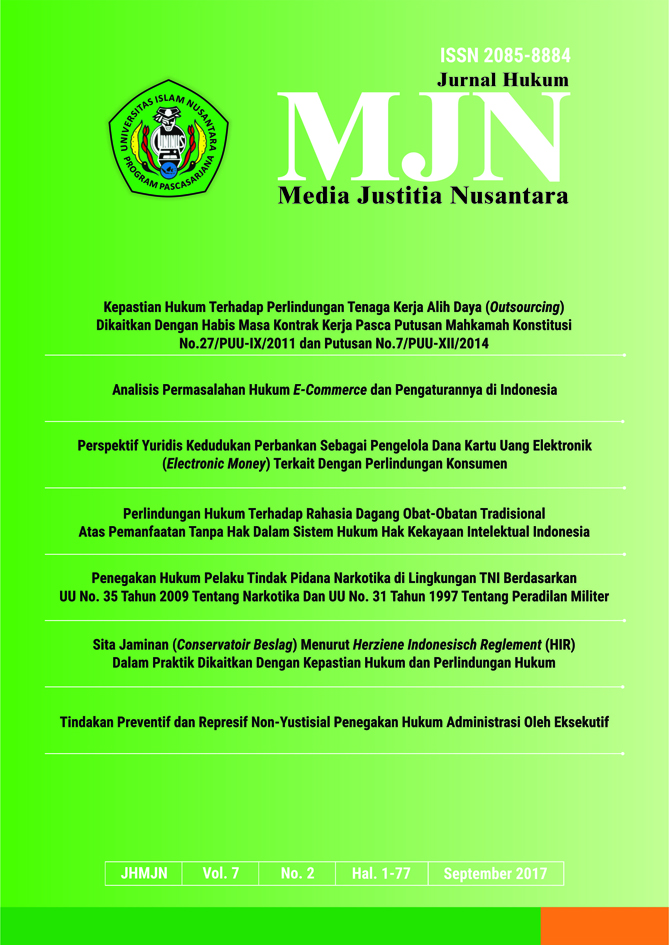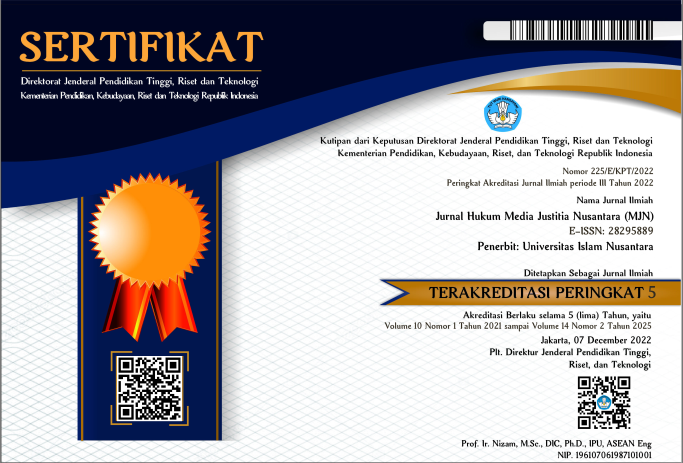Serious crimes and capital punishment in the history of criminal law are two components of closely related issues. This is apparent in the Indonesian Criminal Code which threatens serious crimes with capital punishment. Implementation of capital punishment reap the pros and cons this is motivated by various reasons. Plot murder accompanied by mutilation is a motive for murder committed sadistic and cruel, the motive is done to eliminate traces of deeds that have been done. Planning murder coupled with mutilation as an aggravating factor may be subject to a death sentence, this is because in murder it is not a qualified offense as the basis of ballast. The problem identification in the writing of this thesis involves: how is the existence of capital punishment for the crime of premeditated murder and how the criminal law enforcement related to capital punishment to murder murder is accompanied by mutilation as a burden. The research method used in this compiler is by using the normative juridical method while the specification of writing in this thesis is descriptive analysis, the research stage in this study is primary data obtained from field research and secondary data in the form of primary legal materials, secondary law materials and tertiary legal materials. Based on the description and analysis of the problem it is known that the existence or existence of capital punishment for the crime of premeditated murder is still maintained and valid until now in Indonesia, as it has been in accordance with the provisions of Article 340 of the Criminal Code. The existence of capital punishment as one of the criminal types that is still recognized in the Criminal Law System in Indonesia, is often associated with absolute theory in criminal prosecution. Criminal acts committed by perpetrators are considered very evil, because it interferes with public security, threatens the safety of the people, and is seen as an extraordinary crime (extra ordinary crime). In relation to the crime of premeditated murder as mentioned in Article 581 of the Criminal Code Bill, it also includes a capital punishment, but it can be threatened alternatively with other criminal types, such as life imprisonment or imprisonment of a minimum of five years and a maximum of 20 years. In this case, the draft of the Criminal Code does not specify mutilations specifically as a criminal offense, but if viewed from the provisions of Article 55 paragraph (1) of the Criminal Code Bill, then mutilation may constitute a motive and purpose of committing a crime (letter b); how to commit a crime; as well as the attitude and actions of the producers after committing a crime. As for the suggestion to be conveyed is the government must still maintain the threat of capital punishment by making the rules clearly and firmly against the perpetrators of criminal acts of premeditated murder. The need of the Indonesian Criminal Code is urgent, the government is reasonable, to immediately enact it, so that the provisions contained in Article 55 of the Criminal Code Draft can be used as a guideline for the judge in the imposition of criminal verdict against murder murder with mutilation as incriminating, law, namely the creation of legal certainty, legal benefit, and legal justice.
17-10-2019
Priyono, P. (2019). Eksistensi Pidana Mati Dalam Persfektif KUHP (Studi Kasus Pembunuhan Berencana Disertai Mutilasi Korban Berdasarkan Putusan Mahkamah Agung No. 25 PK/PID/2012). JURNAL HUKUM MEDIA JUSTITIA NUSANTARA, 8(1), 10–22. https://doi.org/10.30999/mjn.v8i1.662
Article
Similar Articles
- Leni Anggraeni, LEGAL PROTECTION FOR WOMEN AND CHILDRENN HUMAN TRAFFICKING CASES: A STUDY OF THE BALE BANDUNG DISTRICT COURT DECISION , JURNAL HUKUM MEDIA JUSTITIA NUSANTARA: Vol. 15 No. 1 (2025): Februari 2025
- Delfika Intania Rosadi, Dini Mulia Mutmainah, Nikolas Andika Simbolon, Hak Waris Hail Perkawinan Kewarganegaraan Campuran Yang Tidak Tercatat , JURNAL HUKUM MEDIA JUSTITIA NUSANTARA: Vol. 13 No. 2 (2023): September 2023
- Suharto AS, Penindakan Peredaran Gelap Obat Daftar G Perspektif Undang-Undang Kesehatan Kaitannya Dengan UndangUndang Narkotika , JURNAL HUKUM MEDIA JUSTITIA NUSANTARA: Vol. 11 No. 1 (2021): Februari 2021
- Siti Hamidah, Perlindungan Hukum Terhadap Rahasia Dagang Obat-Obatan Tradisional Atas Pemanfaatan Tanpa Hak dalam Sistem Hukum Hak Kekayaan Intelektual Indonesia , JURNAL HUKUM MEDIA JUSTITIA NUSANTARA: Vol. 7 No. 2 (2017): September 2017
- Sidik Permana, Implementasi Peraturan Menteri Hukum Dan Hak Asasi Manusia Republik Indonesia Nomor 10 Tahun 2020 Tentang Syarat Pemberian Asimilasi Dan Hak Integrasi Bagi Narapidana Dan Anak Dalam Rangka Pencegahan Dan Penanggulangan Penyebaran Covid-19 Ditinjau Dari Tujuan Pemidanaan Di Indonesia , JURNAL HUKUM MEDIA JUSTITIA NUSANTARA: Vol. 11 No. 2 (2021): September 2021
- Rokhana Rokhana, Kepastian Hukum Terhadap Perlindungan Tenaga Kerja Alih Daya (Outsourcing) Dikaitkan Dengan Habis Masa Kontrak Kerja Pasca Putusan Mahkamah Konstitusi No.27/PUU-IX/2011 dan Putusan No.7/PUU-XII/2014 , JURNAL HUKUM MEDIA JUSTITIA NUSANTARA: Vol. 7 No. 2 (2017): September 2017
- Muhamad Anwar, Efektivitas Penyidikan Terhadap Pelanggaran Ketenaganukliran Berdasarkan Undang-Undang Republik Indonesia Nomor 10 Tahun 1997 Tentang Ketenaganukliran , JURNAL HUKUM MEDIA JUSTITIA NUSANTARA: Vol. 11 No. 2 (2021): September 2021
- Syahrul Machmud, Konsep Strict Liability dalam Hukum Acara Perdata Indonesia , JURNAL HUKUM MEDIA JUSTITIA NUSANTARA: Vol. 7 No. 1 (2017): Februari 2017
- ANNISA SUSINTA, Criminological Review of the Death Penalty Crime Against Drug Crimes in the Perspective of Human Rights Law , JURNAL HUKUM MEDIA JUSTITIA NUSANTARA: Vol. 15 No. 2 (2025): September 2025
- Wahyuddin Rani, Peran Pemasyarakatan Dalam Pelaksanaan Bantuan Hukum Bagi Orang Miskin Demi Terselenggaranya Proses Hukum Yang Adil Dalam Sistem Peradilan Pidana , JURNAL HUKUM MEDIA JUSTITIA NUSANTARA: Vol. 11 No. 1 (2021): Februari 2021
<< < 1 2 3 4 5 6 7 8 9 10 > >>
You may also start an advanced similarity search for this article.













